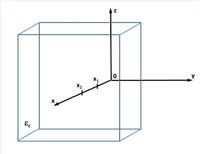Question
In empty space (er = 1), the region x1 <x <x2 is filled with material with a dielectric coefficient er = 8 as a planar infinitely large plate. The geometry is shown in the figure below. Pay attention to the coordinate system placement.
Region I: In (x <x1), the electric field vector was observed as E1 =(4.5) ux + (7.5) uy+(8.5) uz.
Region II : (x1 <x <x2) de er = 8 by determining the electric field E2,
write the value of the x-component: E2x numerically.

Transcribed Image Text:X1
X2
Expert Solution
This question has been solved!
Explore an expertly crafted, step-by-step solution for a thorough understanding of key concepts.
Step by stepSolved in 4 steps

Knowledge Booster
Similar questions
- Part A The figure(Figure 1) shows a thin rod of length L with total charge Q. Find an expression for the electric field E at distance x from the end of the rod. Give your answer in component form. Express your answer in terms of the variables Q, L, x, unit vectors į, j, and appropriate constants. Figure 1 of 1 ΑΣφ 画]? %3D L + +++ + + + + + + + +arrow_forwardConstants A flat sheet of paper of area 0.400 m? is oriented so that the normal to the sheet is at an angle of 56° to a uniform electric field of magnitude 11 N/C. Part A For related problemsolving tips and strategies, you may want to view a Video Tutor Solution of Electric flux through a disk. Find the magnitude of the electric flux through the sheet. Express your answer in newton meters squared per coulomb. Ην ΑΣφ ? N·m²/C Submit Request Answer Part B Does the answer to part A depend on the shape of the sheet? O yes О по Submit Request Answer Part C For what angle o between the normal to the sheet and the electric field is the magnitude of the flux through the sheet largest? Express your answer in degrees. Ην ΑΣφ ? Submit Request Answerarrow_forwardA uniform ring of charge, in the xy plane, centered on the origin, has radius R, and total charge Q. What is the voltage on the z-axis at position z=h? Give the answer in terms of R, Q, h and the constant \epsilon . As usual assume that the voltage at infinity is zero. V(h)=arrow_forward
- A positive particle traveling upwards with initial speed vo = 10°m/s enters a region of uniform electric field pointing rightward. Part A 10 cm and horizontal distance d 4.5cm from the particle's initial location. The particle has What electric field magnitude is needed to direct the particle through the small hole that is located a vertical distance h 10 14kg and charge q 10 °C. Gravity is negligible. Answer to 3 significant figures. mass m N/Carrow_forwardConsider a thin plastic rod bent into an arc of radius R and angle a. The rod carries a uniformly distributed negative charge -Q. (Note: the diagram may have the incorrect sign.) y α R -Q X What is the x component of the electric field at the origin? (Enter your responses in terms of the symbolic quantities mentioned in the problem. To make things easier, just write the letter "a" for the angle a, and use the Coulomb constant k rather than the unwieldy 1/4no.) Ex = k*Q*sin(a)/(a*R^2) Computer's answer now shown above. Tries 0/6 What is the y component of the electric field at the origin? Ey = k*Q*(1-cos(a))/(a*R^2) Computer's answer now shown above. Tries 0/6 Follow the steps outlined in class and in the textbook: 1. Use a diagram to explain how you'll cut up the charge distribution, and draw the AE contributed by a representative piece of charge at a given location. 2. Express algebraically the contribution each piece makes to each vector component of the electric field. Indicate…arrow_forwardanswer please varrow_forward
- please do part d and earrow_forwardCan you help me answer these questions? I am a bit confused.arrow_forwardE ↑ Απεργια This problem checks your understanding of the term in the equation for the electric field due to a point charge, Consider a charged particle at a point S whose coordinates are (4 m, 2 m, 6 m). We would like to find the electric field vector at a point P whose coordinates are (7 m, 8 m, 1 m). The "unit vector" is a vector that points from S to P that has length of 1 (or "unity"). What is its y component, in meters? (Report your answer to one decimal place.)arrow_forward
- Two very large charged parallel metal plates are 15.0 cm apart and produce a uniform electric field of 3.40 10 N/C between them.A proton is fired perpendicular to these plates with an initial speed 5.20 km/s, starting at the middle of the negative plate and going toward the positive plate. Part A How much work has the electric field done on this proton by the time it reaches the positive plate? Express your answer with the appropriate units. W M Value Units Submit Request Answerarrow_forwardNeed help with Barrow_forwardStudents in an introductory physics lab are performing an experiment with a parallel-plate capacitor made of two circular aluminum plates, each 18 cm in diameter, separated by 1.0 cm. Part A How much charge can be added to each of the plates before a spark jumps between the two plates? For such flat electrodes, assume that value of 3 x 106 N/C of the field causes a spark. Express your answer with the appropriate units. qmax = μα Value Units ?arrow_forward
arrow_back_ios
SEE MORE QUESTIONS
arrow_forward_ios